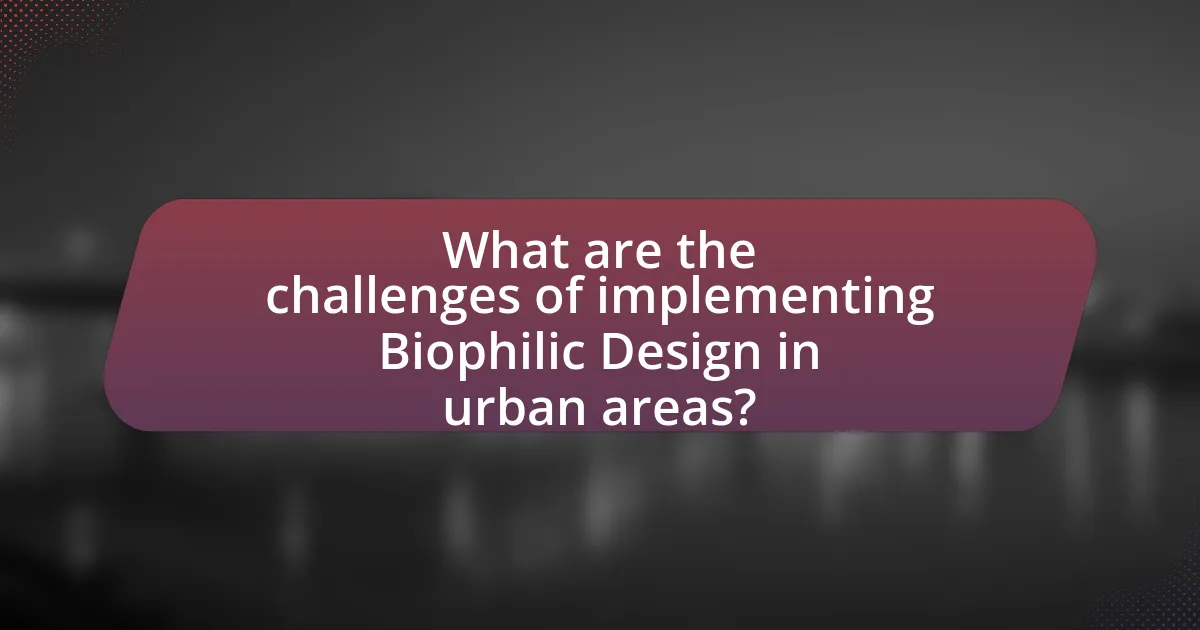Biophilic design in urban spaces emphasizes the integration of natural elements into the built environment to enhance human well-being and foster a connection to nature. This design approach incorporates features such as green roofs, living walls, natural light, and water elements, which have been shown to improve mental health, reduce stress, and increase productivity. The article explores the principles of biophilic design, its psychological and environmental benefits, and the challenges urban planners face in its implementation. Additionally, it highlights successful case studies and best practices for integrating biophilic design into urban planning, emphasizing the importance of community involvement and technological support in creating sustainable urban environments.

What is Biophilic Design in Urban Spaces?
Biophilic design in urban spaces refers to the integration of natural elements into the built environment to enhance human well-being and connectivity to nature. This design approach incorporates features such as green roofs, living walls, natural light, and water elements, which have been shown to improve mental health, reduce stress, and increase productivity. Research indicates that environments designed with biophilic principles can lead to a 15% increase in productivity and a 6% reduction in absenteeism, demonstrating the tangible benefits of such designs in urban settings.
How does Biophilic Design influence urban environments?
Biophilic design significantly influences urban environments by integrating natural elements into architectural and urban planning. This approach enhances the well-being of residents by reducing stress and improving mental health, as evidenced by studies showing that exposure to nature can lower cortisol levels and increase overall happiness. Furthermore, biophilic design promotes biodiversity by incorporating green spaces, which support various species and contribute to ecological balance. Research indicates that urban areas with biophilic features, such as parks and green roofs, experience improved air quality and reduced urban heat, leading to more sustainable living conditions.
What are the key principles of Biophilic Design?
The key principles of Biophilic Design include the incorporation of natural elements, the use of natural light, and the creation of spaces that foster a connection to nature. These principles aim to enhance human well-being and productivity by integrating nature into built environments. For instance, studies have shown that access to natural light can improve mood and cognitive function, while the presence of plants and natural materials can reduce stress and enhance creativity. Additionally, the design often emphasizes views of nature, natural ventilation, and the use of organic forms, which collectively contribute to a healthier and more engaging urban space.
How does Biophilic Design differ from traditional urban design?
Biophilic Design differs from traditional urban design by prioritizing the integration of natural elements into urban environments to enhance human well-being. While traditional urban design often focuses on functionality, aesthetics, and efficiency, Biophilic Design emphasizes the connection between people and nature, incorporating features such as green spaces, natural light, and water elements. Research indicates that environments designed with biophilic principles can improve mental health, reduce stress, and increase productivity, as evidenced by a study published in the Journal of Environmental Psychology, which found that exposure to nature in urban settings significantly enhances psychological well-being.
Why is Biophilic Design important for urban living?
Biophilic design is important for urban living because it enhances the connection between people and nature, leading to improved well-being and mental health. Research indicates that incorporating natural elements into urban environments can reduce stress, increase productivity, and promote overall happiness. For instance, a study published in the Journal of Environmental Psychology found that exposure to nature can significantly lower cortisol levels, a marker of stress. Additionally, biophilic design can improve air quality and biodiversity in cities, contributing to a healthier ecosystem. By integrating green spaces, natural light, and organic materials, urban areas can foster a more sustainable and livable environment for residents.
What psychological benefits does Biophilic Design provide?
Biophilic Design provides significant psychological benefits, including reduced stress, enhanced mood, and improved cognitive function. Research indicates that exposure to natural elements, such as plants and natural light, can lower cortisol levels, which are associated with stress. A study published in the Journal of Environmental Psychology found that individuals in environments with biophilic elements reported a 15% increase in overall well-being and a 6% improvement in cognitive performance. Additionally, biophilic design fosters a sense of connection to nature, which can enhance feelings of tranquility and satisfaction, further contributing to mental health benefits.
How does Biophilic Design contribute to environmental sustainability?
Biophilic design contributes to environmental sustainability by integrating natural elements into urban environments, which enhances biodiversity and reduces resource consumption. This design approach promotes the use of native plants and green spaces, which support local ecosystems and improve air quality. For instance, studies have shown that urban green spaces can reduce the urban heat island effect by up to 5 degrees Celsius, leading to lower energy consumption for cooling. Additionally, biophilic design encourages sustainable practices such as rainwater harvesting and natural ventilation, which further minimize environmental impact.

What are the elements of Biophilic Design in urban spaces?
The elements of Biophilic Design in urban spaces include natural light, vegetation, water features, natural materials, and views of nature. Natural light enhances well-being and productivity, while vegetation, such as trees and green walls, improves air quality and provides habitat for wildlife. Water features, like fountains and ponds, create soothing environments and promote relaxation. The use of natural materials, such as wood and stone, fosters a connection to nature, and views of nature from buildings and public spaces can significantly reduce stress levels. Studies have shown that incorporating these elements can lead to improved mental health and increased social interaction among urban residents.
Which natural elements are commonly incorporated in Biophilic Design?
Natural elements commonly incorporated in Biophilic Design include plants, water features, natural light, and organic materials. These elements enhance the connection between people and nature, promoting well-being and reducing stress. Research indicates that incorporating greenery, such as indoor plants and green walls, can improve air quality and increase productivity. Water features, like fountains or ponds, contribute to a calming atmosphere and can lower noise levels. Natural light is essential for regulating circadian rhythms, while organic materials, such as wood and stone, create a sense of warmth and authenticity in urban environments.
How do plants and greenery enhance urban spaces?
Plants and greenery enhance urban spaces by improving air quality, reducing heat, and promoting biodiversity. Specifically, vegetation absorbs pollutants and carbon dioxide, releasing oxygen, which contributes to cleaner air. Studies indicate that urban greenery can lower temperatures by up to 5 degrees Celsius, mitigating the urban heat island effect. Furthermore, the presence of plants supports various species, fostering biodiversity within city environments. Research published in the journal “Urban Forestry & Urban Greening” highlights that green spaces can increase mental well-being and social cohesion among urban residents, demonstrating their multifaceted benefits in enhancing urban living conditions.
What role does water play in Biophilic Design?
Water plays a crucial role in Biophilic Design by enhancing the connection between humans and nature, promoting well-being and tranquility. The incorporation of water features, such as fountains, ponds, or streams, creates a sensory experience that can reduce stress and improve mental health. Research indicates that exposure to water elements can lower cortisol levels, which are associated with stress, thereby fostering a calming environment. Additionally, the sound of flowing water has been shown to improve focus and concentration, making it beneficial in urban spaces where noise pollution is prevalent.
How can light and space be utilized in Biophilic Design?
Light and space can be utilized in Biophilic Design by maximizing natural light and creating open, airy environments that connect occupants with nature. Natural light enhances mood and productivity, as studies show that exposure to daylight can improve well-being and reduce stress levels. Additionally, incorporating large windows, skylights, and open floor plans allows for unobstructed views of nature, fostering a sense of connection to the outdoors. Research indicates that environments designed with ample natural light can lead to a 15% increase in productivity and a 23% reduction in absenteeism, demonstrating the effectiveness of these design principles in urban spaces.
What are the effects of natural light on urban inhabitants?
Natural light positively affects urban inhabitants by enhancing mood, productivity, and overall well-being. Exposure to natural light has been linked to increased serotonin levels, which can improve mood and reduce feelings of depression. Studies show that workplaces with ample natural light can boost employee productivity by up to 15%. Additionally, natural light helps regulate circadian rhythms, leading to better sleep quality and health outcomes. Research from the University of Oregon indicates that access to daylight in urban environments can significantly improve mental health and reduce stress levels among residents.
How does spatial organization impact user experience in urban areas?
Spatial organization significantly impacts user experience in urban areas by influencing accessibility, navigation, and social interaction. Well-planned spatial layouts enhance pedestrian flow, reduce congestion, and create inviting environments that encourage community engagement. For instance, research by Gehl Architects highlights that cities designed with clear pathways and open spaces foster social interactions and improve overall satisfaction among residents. Additionally, studies indicate that urban areas with integrated green spaces and biophilic elements lead to increased well-being and reduced stress levels, as evidenced by findings from the University of Queensland, which show that exposure to nature in urban settings positively affects mental health.

What are the challenges of implementing Biophilic Design in urban areas?
The challenges of implementing Biophilic Design in urban areas include limited space, regulatory constraints, and financial barriers. Urban environments often have high population density, which restricts the availability of land for green spaces and natural elements. Additionally, existing zoning laws and building codes may not accommodate biophilic features, making it difficult for developers to integrate them into new projects. Financially, the initial costs of incorporating biophilic elements, such as green roofs or living walls, can be significant, deterring investment despite potential long-term benefits like improved air quality and enhanced well-being. These factors collectively hinder the widespread adoption of Biophilic Design in urban settings.
What barriers do urban planners face in adopting Biophilic Design?
Urban planners face several barriers in adopting Biophilic Design, primarily including budget constraints, regulatory challenges, and a lack of public awareness. Budget constraints limit the ability to implement nature-based solutions, as these designs often require upfront investment that may not be prioritized in urban planning budgets. Regulatory challenges arise from existing zoning laws and building codes that may not accommodate or encourage Biophilic elements, making it difficult for planners to integrate these designs into their projects. Additionally, a lack of public awareness and understanding of the benefits of Biophilic Design can hinder community support, which is crucial for successful implementation. These barriers collectively impede the widespread adoption of Biophilic Design in urban environments.
How can budget constraints affect Biophilic Design projects?
Budget constraints can significantly limit the scope and quality of Biophilic Design projects. When financial resources are restricted, project developers may prioritize cost-effective solutions over innovative designs that fully integrate natural elements, which are essential for achieving the intended benefits of Biophilic Design. For instance, a study published in the Journal of Urban Design indicates that projects with limited budgets often resort to cheaper materials and simplified landscaping, which can diminish the aesthetic and psychological advantages associated with nature-rich environments. Consequently, budget limitations can lead to a less effective implementation of Biophilic principles, ultimately impacting the well-being of occupants and the overall success of urban spaces.
What regulatory issues may arise with Biophilic Design initiatives?
Regulatory issues that may arise with Biophilic Design initiatives include compliance with zoning laws, building codes, and environmental regulations. These regulations can restrict the integration of natural elements into urban spaces, as they often dictate the types of materials used, the design of structures, and the preservation of existing ecosystems. For instance, local zoning laws may limit the height or footprint of buildings, impacting the feasibility of incorporating green roofs or vertical gardens. Additionally, environmental regulations may require assessments of how Biophilic Design elements affect local wildlife and ecosystems, potentially complicating project approvals.
How can community involvement enhance Biophilic Design efforts?
Community involvement can enhance Biophilic Design efforts by fostering a sense of ownership and ensuring that designs reflect the needs and preferences of local residents. Engaging community members in the design process leads to more relevant and culturally appropriate green spaces, which can increase usage and appreciation. Research indicates that projects incorporating community feedback are more successful; for instance, a study by the University of Washington found that community-designed parks saw a 30% increase in visitor satisfaction compared to those designed without input. This active participation not only improves the aesthetic and functional aspects of Biophilic Design but also strengthens community ties and promotes environmental stewardship.
What strategies can be used to engage the community in Biophilic projects?
To engage the community in Biophilic projects, strategies such as participatory design workshops, educational programs, and community-led initiatives can be employed. Participatory design workshops allow community members to contribute ideas and preferences, fostering a sense of ownership and connection to the project. Educational programs can raise awareness about the benefits of Biophilic design, such as improved mental health and environmental sustainability, thereby increasing community interest and involvement. Community-led initiatives, where local residents take the lead in implementing Biophilic elements, can further enhance engagement by ensuring that projects reflect the unique needs and desires of the community. These strategies have been shown to increase community buy-in and support for Biophilic projects, leading to more successful and sustainable outcomes.
How does community feedback shape Biophilic Design outcomes?
Community feedback significantly shapes Biophilic Design outcomes by ensuring that the design reflects the needs and preferences of the local population. Engaging with community members allows designers to gather insights on how natural elements can be integrated into urban spaces in ways that resonate with users. For instance, studies have shown that projects incorporating community input, such as the design of parks or green roofs, often result in higher usage rates and satisfaction levels among residents. This is supported by research from the University of Queensland, which found that community involvement in design processes leads to more effective and sustainable biophilic interventions.

What are the best practices for integrating Biophilic Design in urban planning?
The best practices for integrating Biophilic Design in urban planning include incorporating natural elements, enhancing connectivity to nature, and promoting biodiversity. Urban planners should prioritize green roofs, living walls, and urban forests to create spaces that mimic natural ecosystems. Research indicates that access to green spaces can improve mental health and well-being, with a study by Kaplan and Kaplan (1989) highlighting the restorative effects of nature on urban dwellers. Additionally, planners should design walkable environments that encourage outdoor activities and social interactions, as these features foster community engagement and enhance the overall quality of life. Implementing water features, such as ponds and streams, can also create habitats for wildlife and improve urban aesthetics, further supporting the principles of Biophilic Design.
How can urban designers effectively incorporate Biophilic principles?
Urban designers can effectively incorporate Biophilic principles by integrating natural elements into urban environments, such as green roofs, living walls, and urban parks. These design strategies enhance the connection between people and nature, which has been shown to improve mental well-being and reduce stress levels. Research indicates that exposure to nature can increase productivity and creativity; for instance, a study published in the Journal of Environmental Psychology found that individuals working in environments with natural elements reported higher levels of satisfaction and lower levels of fatigue. By prioritizing these elements in urban planning, designers can create spaces that foster a healthier and more sustainable urban experience.
What are successful case studies of Biophilic Design in cities?
Successful case studies of Biophilic Design in cities include the High Line in New York City, Singapore’s Gardens by the Bay, and the Bosco Verticale in Milan. The High Line transformed an abandoned railway into a green space that integrates nature with urban life, attracting over 8 million visitors annually and enhancing local biodiversity. Gardens by the Bay features innovative vertical gardens and climate-controlled domes, showcasing sustainable practices and drawing 18 million visitors each year. Bosco Verticale consists of residential towers adorned with over 9,000 trees, improving air quality and providing habitat for urban wildlife. These projects exemplify how Biophilic Design can enhance urban environments, promote sustainability, and improve residents’ well-being.
How can technology support Biophilic Design initiatives?
Technology can support Biophilic Design initiatives by enabling the integration of natural elements into urban environments through innovative tools and systems. For instance, smart sensors can monitor environmental conditions, such as air quality and temperature, allowing for the optimization of green spaces to enhance biodiversity and human well-being. Additionally, augmented reality applications can simulate natural landscapes, helping architects and urban planners visualize and implement biophilic elements effectively. Research indicates that incorporating technology in this manner can lead to improved mental health outcomes and increased user satisfaction in urban settings, as evidenced by studies showing that access to nature in urban areas reduces stress and enhances overall quality of life.
What practical tips can urban planners follow for Biophilic Design?
Urban planners can enhance biophilic design by integrating natural elements into urban environments. This can be achieved through strategies such as incorporating green roofs and vertical gardens, which not only improve air quality but also provide habitats for urban wildlife. Additionally, planners should prioritize the creation of parks and green spaces that encourage community interaction and promote mental well-being, as studies show that access to nature reduces stress and enhances overall health. Furthermore, utilizing natural materials in construction and designing buildings that maximize natural light can foster a connection to the outdoors. Research indicates that environments rich in natural elements can lead to increased productivity and creativity among residents.
How can planners assess the needs of urban populations for Biophilic Design?
Planners can assess the needs of urban populations for Biophilic Design by conducting surveys and community engagement initiatives to gather direct feedback from residents. This approach allows planners to understand preferences for natural elements, such as green spaces and water features, which are essential components of Biophilic Design. Research indicates that urban populations benefit from increased access to nature, as evidenced by a study published in the Journal of Environmental Psychology, which found that exposure to natural environments significantly enhances well-being and reduces stress. By analyzing demographic data and existing urban conditions, planners can identify areas lacking in biophilic elements and prioritize interventions that align with community needs and desires.
What resources are available for implementing Biophilic Design in urban spaces?
Resources available for implementing Biophilic Design in urban spaces include design guidelines, case studies, and educational programs. The “Biophilic Design Toolkit” by the Biophilic Design Initiative provides practical strategies and examples for integrating nature into urban environments. Additionally, the “Nature of Cities” platform offers a wealth of case studies showcasing successful biophilic projects worldwide, demonstrating the positive impacts on urban living. Educational resources, such as workshops and online courses from institutions like the University of Virginia, further equip urban planners and designers with the knowledge to effectively apply biophilic principles.





